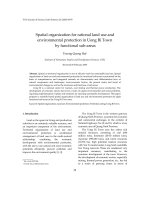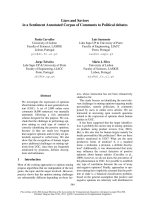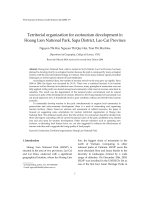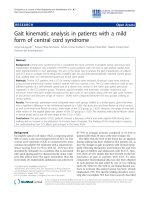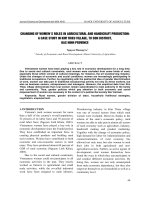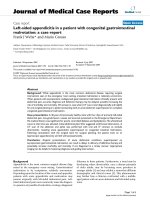Báo cáo "Territorial organization for ecotourism development in Hoang Lien National Park, Sapa District, Lao Cai Province " pdf
Bạn đang xem bản rút gọn của tài liệu. Xem và tải ngay bản đầy đủ của tài liệu tại đây (191.58 KB, 9 trang )
VNU Journal of Science, Earth Sciences 24 (2008) 1-9
1
Territorial organization for ecotourism development in
Hoang Lien National Park, Sapa District, Lao Cai Province
Nguyen Thi Hai, Nguyen Thi Quy Hoi, Tran Thi Mai Hoa
Department of Geography, College of Science, VNU
Received 8 March 2008; received in revised form 24 June 2008
Abstract. Hoang Lien National Park, what is located in Sa Pa District, Lao Cai Province, has been
planned to develop priority in ecological tourism because the park is composed by many ecological
systems with the most diversiform biology in Vietnam. Here exists many endemic species, beautiful
landscapes, as well as typical cultures of local inhabitants.
According to statistical data, the number of tourism arrivals to the area grew up rapidly. Since
2000 to 2006, the figure was increased by 39.1%. There was a continual increase in its tourism
revenue as well as diversity in its effective tours. However, many principles of ecotourism were not
fully applied. Little profit was shared among local community while most of revenue came back to
outsiders. The result was the degradation of the national park’s environment and its natural
resources in spite of the development of tourism. Moreover, the living standard of local people was
not much improved: 21% of households lived in poor condition without any benefit from tourism
activities.
To sustainably develop tourism in the park, simultaneously to support local community in
preservation and socio-economic development, there is a need of researching and organizing
tourism territory. Hence, based on analysis and assessment of related resources, the paper is
focused on suggesting some orientations for tourism territorial organization of Hoang Lien
National Park. The obtained results show that the territory for ecotourism should be divided into
three sub-regions coinciding with its current functional zones of the park: prohibited area, limited
area and area open for tourism development. Other relevant solutions such as operating new
ecotours, re-educating local human force, etc. are also suggested to enhance the effectiveness of
tourism activities and to upgrade the living quality of local people.
Keywords: Ecotourism; Territorial organization; Hoang Lien National Park.
1. Introduction
*
Hoang Lien National Park (HLNP) is
situated in the area of two provinces, Lao Cai
and Lai Chau, endowed with a significant
geographical location, where lies Hoang Lien
_______
* Corresponding author. Tel.: 84-4-8581420
E-mail:
Son, the biggest chain of mountains in the
north of Vietnam. Comparing to other
national parks of Vietnam, HLNP owns the
most abundant flora and fauna thanks to the
diversity in landscapes formed by a wide
range of altitudes. On December 18th, 2003,
HLNP was inscribed in the UNESCO's list as
one of the first four Asian Heritage Parks in
Nguyen Thi Hai et al. / VNU Journal of Science, Earth Sciences 24 (2008) 1-9
2
Vietnam [3]. More and more tourists have
been attracted by its typical natural
landscapes and unique culture.
Though being as a National Park (NP) for
a long time, HLNP could not avoid a serious
degradation of its forestry due to negative
activities such as spontaneous and unplanned
field tilling; excessive hunting; fire caused by
agricultural activities; cardamom planting,
which resulted in the reduction of leaf-layers'
thickness and, in turn, prevented the
reproduction of trees. The reasons mainly
come from the poverty of its community,
whose economy is highly depended on forest
resources. Statistics in Sapa District show that
22.9% of households who live in the core of
the National Park have much lower income
than the average of national standard [1].
In this case, ecotourism development is
claimed to be a powerful tool to harmoniously
obtain three targets: socio-economic
development, resource preservation and
tourism development. In order to reach the
goals, tourism zoning is a fundamental step.
It is impossible to have an effective tourism
management without considering its spatial
organization, which is even more important
in national parks where tourism must come
hand in hand with conservation to improve
local living standard.
2. Methodology for tourism territorial
organization in National Parks
Territorial organization is simply defined as
a way to make best use of territory. Thus,
territorial organization for tourism (TOT) is
the effective spatial division of tourism based
on its natural resources, infrastructure and
facilities, and labor force as well as other
arising factors in correspondence with those
of other industries in other regions.
In other words, territorial organization
for tourism is a system of spatial inter-
connection between tourism subjects and its
related service properties, based on the
optimal use of tourism development
resources (natural and socio-economic) to get
the best effectiveness in terms of economy,
society and environment [4].
Researches on TOT and plans for effective
spatial organization will set the basic
information to efficiently exploit tourism
forces (especially the natural resources) of the
country in general, and of the local area in
particular. It will also accelerate the process
of specialization in tourism industry, thus
create more valuable and typical tourist
products to enhance its competitiveness.
The main targets of establishing NPs are
to preserve the bio-diversity and territorial
unity, to serve educational and scientific
functions and to provide favorable environment
for tourism. As the result, NPs are ideal
places for tourism development. Nonetheless,
like two sides of a coin, tourist activity may
easily cause damage to NPs if it is not well
planned and managed. That’s why territorial
organization for ecotourism development
(TOET) in NPs is of great necessity.
TOET in NPs should, first and foremost,
aim at organizing a tourism spatial system in
which tourism subjects and related service
properties are closely connected through the
optimal use of tourism forces, facilities, and
other belonging elements in order to
maximize the benefits for the sake of socio-
economics and environment. To be specific, it
must obey several principles: have typical
ecotourism establishments; consciously
propagate environmental education;
harmoniously use the territory for both
tourist and preservative functions [2].
TOT will only succeed if it obtains all of
four following targets: the satisfactory of
Nguyen Thi Hai et al. / VNU Journal of Science, Earth Sciences 24 (2008) 1-9
3
tourists, the efficiency of economy, the
preservation of tourism resources and the
solidarity of its local community and tourism
units [2].
3. Forces for TOET in Hoang Lien National
Park
HLNP is situated in the northwest of Sapa
District, at the triangle of boundaries of three
provinces: Lao Cai, Hoa Binh, and Son La. Its
geographical coordinates are between
22
0
22’55” and 22
0
08’00” of the Northern
latitudes and between 103
0
45’20” and
103
0
59’40” of the Eastern longitudes.
The park is bordered by the following
villages: Ta Phoi (Lao Cai Town), Thanh Kim,
Nam Sai, Nam Cang (Sa Pa District) and Nam
Xe (Van Ban District) in the East; Ta Giang
Phin, Ta Phin, Ban Khoang and Trung Trai
(Sa Pa District) in the North; Phong Tho
District (Lai Chau Province) and Muong
Khoa village (Than Uyen District) in the
West; Ho Mit, Than Thuoc, Muong Khao
villages (Than Uyen District) and Van Ban
District in the South.
3.1. Natural tourism resources
Hoang Lien National Park, with the total
area of 29845 ha, is situated in a region where
relief is very complex and diverse, prevailed
by medium to high mountains of Hoang Lien
Son massif - the highest and most marvelous
chain of mountains in Vietnam. There are
handfuls of over 2000 meters high peaks. The
highest is Fansipan (3143 m) - favorably
called “The roof of Indochina”. The average
slope is quite high, 25
0
- 35
0
; some may reach
40
0
- 45
0
. Topography changes wildly in terms
of altitude, the widest difference can be 1000-
1500m, forming distinct and separated reliefs.
Scattered among the foot of huge mountains
are fertile valleys deposited by alluvia such as
those in Ta Van, Lao Chai, and Ban Ho
communes.
Belonging to subtropical and temperate
zone in mountainous region, the climate in
Hoang Lien National Park is temperate and
cool all year round. The quickly-changing
weather right within a day attracts thousands
of tourists annually. Visitors can experience
all four seasons among a day’s time. In
winter, snow sometimes appears [1].
Distinct relief is the main cause of densely
hydrographic system characterized by
narrow and deep streams, steep currents. In
turn, it creates a lot of falls, forming plenty of
alluring landscapes valuable for tourism
activity in the park, for instance, Thac Bac
(Silver Waterfall), Thac Tinh Yeu (Love
Waterfall), Suoi Vang (Yellow Stream), etc.
Flora in HLNP represents almost all forest
types in Vietnam. Several dominant plants on
mountainous area are unique in Vietnam
such as primeval cold-bearing plants living in
temperate condition on high mountains of
over 2800m with predominance of unique
low forest type; a complex of thin-and-thick-
leaf plants at the height of 2700-2800m
prevailed by Sam bong lanh - a typical cold-
bearing plant; a complex of plants dominated
by Do Quyen (Rhododendron) [1].
Claimed to have the most abundant
biodiversity of all Vietnamese specialized
forests, Hoang Lien is native to 2343 types of
plants, 96 types of animals, 343 types of birds,
113 types of reptiles and amphibians, many of
which are in danger situation and have been
inscribed in both Vietnam’s and World’s Red
Book. Moreover, the uniqueness of HLNP is
also in the top of Vietnam specialized forests
with 17.9% of all rare plants. 5 types of birds
Nguyen Thi Hai et al. / VNU Journal of Science, Earth Sciences 24 (2008) 1-9
4
and 6 types of reptiles, amphibians are found
nowhere but here throughout Vietnam [1].
3.2. Human tourism resources
There are 5 main ethnic groups who are
living in the area of HLNP in Sapa, namely
H’Mong, Red Yao, Day, Tai and Thai, among
those H’Mong is the majority, accounting for
71% of the total population [1]. Each group
established their own territory into a
separated village. H’Mong people usually
prefer to live in the high land, while Yao, Day
and Tai people live in lower places. The
population density of each village is also
greatly differentiated.
Most of their income comes from farming,
animal husbandry and forestry. Due to the
lack of cultivatable land and labor, and low
efficiency of production in correspondence
with a high proportion of not-working force,
there are a large number of households living
below normal standards. Those in four
villages in HLNP account for about 22.2% of
all households in poverty in the district. The
annual average amount of rice per person is
only 220kg, even less than the minimum
worldwide indicator (260kg/person).
However, the human resources are
abundant. The inaccessibility to this
adventurous zone resulted in its traditional
culture, barely influenced by outsiders. They
have long established good relationships each
with other. At the same time, they still keep
their culture distinct in forms of social
hierarchy, house structure, way of farming,
customs, festivals, traditional folklores,
religious beliefs and rituals, etc. The cultural
diversity makes strong attraction to tourists.
It is clear that human tourism resources in
HLNP are well served the demand of
ecotourism development.
3.3. Infrastructure and facilities for tourism
Generally speaking, transport system is
quite an advantage of the park to connect it
with its generating sources. Only 40km away
from Lao Cai Town to the northwest, Hoang
Lien can easily be accessed through the
extended National Road 4D by cars and
motorbikes. However, transportation within
the park is limited. People coming to the park
for sightseeing, natural exploring or visiting
community in the core of the park have no
choice but to walk or climb along small land-
paths. Moreover, these paths are quite
dangerous because of landslide on rainy season.
Electricity and water supply are
insufficient. All of villagers in the core of the
park are disconnected to the national
electricity network. Hydroelectricity generated
by small streams is the main source of power
and can serve only a half of households. This
situation is a drawback for tourism
development.
Local people in HLNP mainly use water
from streams brought to the villages by
natural canal and traditional bamboo
irrigation system. Some even have to use
farming water in daily life. Only a few
villages like Ban Den, Cat Cat and Sin Cha,
which are located near important roads
connecting communes together, have their
reservoirs constructed thanks to the 135
Project sponsored by UNICEP and ADB.
Telecommunication in the park has
improved recently. Almost all villages have
set up telephone system. Nonetheless, only a
limited number of households could install
home phone. In terms of mobile phones,
signals are restricted due to geographical
hindrance; thus, it is hard to contact now and
then. It is a big problem for tourist security
emergency case.
Nguyen Thi Hai et al. / VNU Journal of Science, Earth Sciences 24 (2008) 1-9
5
4. Current tourism activities and territorial
organization in HLNP
4.1. Current tourism activities
Marvelous landscapes and unique ethnic
culture attracts more and more tourists to
Sapa District in general, and to HLNP in
particular. Statistics reveal that tourist
arrivals shot up to 259,079 visitors in 2006,
five times to that in 2000 (49,322). On average,
it increased 39.1% annually between 2000 and
2006 [3]. There is a variety of tourism
activities: from natural-based tourism like
walking or climbing on mountains, landscape
sightseeing, biology researching, or
adventurous trips (Fansipan trekking, sports
tours) to cultural tourism like village visiting,
community-based activities etc. Usually, the
visitors choose mixed types.
Individual studies show that there is a
balance ratio between international and
domestic tourists visiting HLNP, with a slight
larger figure of foreigners in trekking tours.
International tourists stay relatively longer
than domestics, 4-5 days compared to 2-3
days in average. However, few of them know
about HLNP due to its ineffective
advertisement and lack of educational and
environmental explanation. Even during the
visit to ethnic communities, such as Seo Mi
Ty, Ta Trung Ho, Cat Cat, Sin Chai, tourists
are rarely conscious of their entering the core
of the park. Mainly who conquered Fansipan
are the ones to have knowledge of HLNP,
which makes up a very small proportion.
4.2. Current management and territorial
organization based on principles of ecotourism
* Permanent tours
Permanently, tourist sites in HLNP and
their related tours have not been effectively
and widely exploited. Management is too
complex to succeed. There are mainly two types
of tours differentiated by who manages them.
Ecotourism tours within the National
Park supervised by the Centre for
Environmental Education and Ecotourism [3]:
(1) Fansipan conquesting tour:
+ 2-days tour: Sa Pa - Tram Ton - Fansipan
- Tram Ton – Sa Pa;
+ 3-days tour: Sa Pa - Tram Ton - Fansipan
- San Chai - Sa Pa; Tram Ton - Fansipan - Seo
Mi Ty;
+ 4-days tour: Sa Pa - Tram Ton - Fansipan
- Cat Cat - Sa Pa.
(2) Sa Pa - Ta Van - Seo Mi Ty - Ta Trung
Ho - Ban Ho - Sa Pa (4 days).
(3) Tram Ton - Fansipan - Seo Mi Ty - Den
Thang - Seo Trung Ho (7 days).
(4) Sa Pa - Tram Ton - Suoi Vang - Thac
Tinh Yeu (one day).
(5) Sa Pa - Cong Troi - Suoi Vang - Thac
Tinh Yeu (one day).
(6) Cat Cat - Y Linh Ho - Lao Chai - Ta
Van (one day).
(7) Tram Ton - Rung Gia - Thac Bac - Sin
Chai (one day).
(8) Sa Pa - Ta Van - Seo Mi Ty - Den Thang.
(9) Sa Pa - Ban Ho - Seo Trung Ho - Ta
Trung Ho.
(10) Sa Pa - Lao Chai - San I - San II.
It can be seen that there is an unequal
distribution of tourists in different tours.
Those supervised by Department of Trade
and Tourism attract a larger number of
tourists thanks to convenient accessibility. In
tourist seasons, an overwhelming number of
tourists cause negative effects on natural
resources and environment. In contrast, the
visitors rarely know about tours deep into the
park, thus their economic and educational
impact is low for tours organized by Center
Nguyen Thi Hai et al. / VNU Journal of Science, Earth Sciences 24 (2008) 1-9
6
for Environmental Education and Ecotourism.
* Level of fulfillment of educational functions
and environmental explanations
Ecotourism can be distinguished from
other types of tourism by its educational and
environmental functions. This is denoted by
providing tourists with natural, biological
and cultural value of the destination,
enhancing visitors’ appreciation for
environment with the help of tour-guides or
mass media.
In the case of HLNP, these functions were
not fulfilled yet. There are a surprising small
number of tourists who are made known of
the park, not mention their consciousness of
Hoang Lien’s value. Furthermore, tour-
guides had little chance to provide this kind
of information as a large amount of visitors
don’t hire guides, 70.37% of domestic tourists
and 57.14% of foreigners.
* Level of assurance for ecotourism quality
Almost all international tourists are quite
satisfied with ecotourism in the park and its
current services. They are willing to suffer
from the lack of normal standards of
infrastructure and tourism facilities for the
nature of marvelous landscapes and
traditional living style of local people.
On the contrary, domestic tourists are not
completely satisfied. Their limited time does
not allow them to explore the nature, which
they think is beyond their withstanding of
health and finance. Instead, they only visit
famous near-by sites, which are convenient
to access; thus, Sapa Town is their favorite.
Consequently, their main comments come to
tourism facilities, transportation upgradation.
Some complains about a high price of
ecotourism to conquer Fansipan or the
management and quality of tour guides. In
the other hand, foreign tourists' comments
focus on environmental conservation and
experience gained after the trip.
* Relationship between ecotourism and
conservation
It is suitable to develop ecotourism in
HLNP. It not only helps to fulfill the need for
understanding and living close to the nature
but also enhances visitors’ consciousness and
responsibility to preserve natural, cultural
and environmental value of the destination.
Moreover, it economically supports
conservative function of the park.
Now, HLNP management board is
partially financed by the money from
ecotourism activities leaded by the Center for
Environmental Education and Ecotourism
and a proportion of entrance fee. Ecotourism
also maintains the relationship with national
and international organizations, attracting
research and investment projects by
preservation units such as animal
conservative organization, multi-national
zoology organization, IUCN, and so on.
Furthermore, developing ecotourism
spares room for restoration of traditional
festivals and customs, which are on the verge
of extinction, for example, mua khen, hat giao
duyen (traditional folklore and dance) and
other famous handicrafts.
* Relationship between ecotourism and local
community
Tourism industry has financially
supported the local community, both
individual and social as a whole. However,
there is a wide gap between different groups.
Kinh people who live near or within the town
and the frontiers of the park get quite a high
income, approximately 1-3 millions VND/
person/month, doing business such as
accommodation and restaurant operation or
photographing. H’Mong, Yao, Tai people
who live in the area of the park make use of
tourism by selling hand-made products,
Nguyen Thi Hai et al. / VNU Journal of Science, Earth Sciences 24 (2008) 1-9
7
souvenirs, working as tour guides, porters or
using their houses as tourist accommodation
or visiting sites. They can earn 100.000-
600.000 VND/person monthly. Others, who
live deeply at the core of the park, get almost
nothing from tourism.
5. Orientations and solutions for ecotourism
territorial organization in HLNP
As the growing demand of tourism in
Vietnam as well as in National Parks still goes
on, developing ecotourism in HLNP is the
right orientation for its sustainability. Based
on national and provincial strategies and
policies, added with present tourism
conditions, it is high time principles of
community-based ecotourism were fully
considered in developing the province’s
tourism plan. The next sessions are major
suggestions to pay attention to.
5.1. Spatial organization for ecotourism territory
Spatial organization for ecotourism
territory is the key to the conservation in
National Parks, setting seeds for tourist
management to ensure sustainable
development. Territory for ecotourism should
be divided into sub-regions with different
functions based on current functional zones
of the park:
- Prohibited area: is the area for strictly
conservative function, including Fansipan
region of 11,875 ha, which is home to
primitive ecosystem with many unique and
endangered flora and fauna. This only opens
for intensive researches or strictly observed
ecotourism activities. To enter this zone,
several principles are applied:
Fig. 1. Hoang Lien National Park ecotourism zoning map.
Nguyen Thi Hai et al. / VNU Journal of Science, Earth Sciences 24 (2008) 1-9
8
- Limited area: is the zone for re-
habitating the ecology of the park, which
covers the area of some popularly-visited
villages like Sin Chai, Ban Den, Ta Trung Ho,
Lao Chai San, etc. This zone is considered as
the buffering zone of the park to maintain
bio-diversity of the prohibited area and
support conservative function. In this zone, a
few ethnic groups still keep their simple life
which is said to be well-adapted to the
unspoiled nature and an advantage to
operate other ecotourism activities besides
ecotours. They are sightseeing, village-
visiting, camping, community-based activities.
However, tourism activities should be
strictly supervised in order to minimize their
environmental impacts. Natural resources can
be used for tourism with a controlled and
limited amount. Advance registration is
required. Intensified environmental education
is given to enhance the quality of ecotourism.
Carrying capacity is desired. Motorbikes and
cars are possible to use but simple modes like
bikes, animal-drawn carriage are encouraged.
Regulations and rules are fully announced for
good cooperation from tourists. Budget
should be allotted to educate local people and
help them start their business from tourism
activities (e.g. initial investment in handicraft
activities).
- Area open for tourism development:
includes the area of the communes on the
boundary of the park’s buffer and those along
inter-provincial roads. Tourism services may
be in form of accommodation renting,
shopping. In this zone, Sapa Town plays a
role of logistics, as well as the most significant
welcome-gate for eco-visitors to the park.
5.2. Operating more ecotours
In order to satisfy increasing demand, it is
necessary to carry out further research and
operate more ecotours besides the current
ones. For example, eco-managers and tour
operators could bring the following sites into
operation: Deo May (Cloudy mountain pass),
Fairy Forest, Low Bamboo Forest, Muong
Hoa Valley, Ta Van Day plum farm, Ta Van
Mong plum farm, Ban Ho terraced fields. In
addition, there should be a flexible
combination between recent ecotours and
tours to the buffer area to diversify and
widen tourism territory. Possible tours can
be: Tram Ton - Fansipan - Y Lin Ho; Sapa-Thac
Bac - Tram Ton - Lau Vong Canh - Deo May -
Sapa; village-specialized tours and community
based tours to Ta Van Day plum farm, Ta
Van Mong plum farm. Multi-provincial and
multi-national ecotours should also be
encouraged. For the best result, a close
cooperation between Department of Trade
and Tourism of Sapa and Centre for
Environmental Education and Ecotourism is
required.
5.3. Proposals
To accomplish the above orientations for
successful ecotourism development, the
following solutions should be implemented
simultaneously:
- Create favorable policies to attract FDI
and domestic investment on doing researches,
exchanging education and knowledge on
planning, managing and operating ecotourism
effectively.
- Strengthen management and
supervision in order to assure that ecotourism
principles are fully applied. Other schemes,
fees, rules and regulations should be set as
deteration tools in addition to scientific
management based on carrying capacity.
- Reinforce the market studies in parallel
Nguyen Thi Hai et al. / VNU Journal of Science, Earth Sciences 24 (2008) 1-9
9
with advertisement on ecotourism in HLNP
through all types of mass media, namely
radio, newspapers, internet, etc.
- Consolidate infrastructure and facilities
for ecotourism. Special attentions should be
put to operating more tours and tourist sites
aiming at spatially redistributing the
overcrowding trips in a specific place, thus
minimizing the environmental impacts.
- Intensify environmental education:
education and reeducation, improvement of
knowledge, experience and consciousness for
both managers and labors; widen mass media
effects on environmental education for
tourists and local communities
- Attract the local people to participate
and help them to get benefits from tourism
activities, thus improving their living
standard.
6. Conclusions
Hoang Lien National Park, situated on a
huge range of mountains, characterized by
abundant and unique natural and cultural
attributes, is highly potential for ecotourism
activities. Developing ecotourism here not
only benefits tourists but also supports the
bio-diversity conservation. It can be a powerful
tool for poverty alleviation to households in
the deep end of the park. However, it is an
uneasy task. To construct sustainable
ecotourism, further researches should be
carried out, and the territory should be well
organized. A system of solutions should be
implemented to harmoniously target at two
aims: economic and conservative. It is highly
recommended that local people be involved
in and get benefits from tourism activities to
reach a better living condition, which in turn
lowers the pressure of resources’ destruction.
Only then the management board will be able
to fulfill its functions.
This paper was completed within the
framework of Fundamental Research Project
702506 funded by Vietnam Ministry of
Science and Technology.
References
[1] Ministry of Agriculture and Rural Development,
Institute of Forest Research and Planning, Project
of Investment in Hoang Lien National Park, Lao Cai
Province, Hanoi, 2003 (in Vietnamese).
[2] Nguyen Thi Hai, Nguyen An Thinh, Ecotourism
Territorial Organization for socio-economic
development and resource conservation in Sa
Pa, Lao Cai Province, VNU Journal of Science,
Natural Sciences and Technology No. 5PT/XXI
(2005) 35 (in Vietnamese).
[3] Lao Cai Department of Trade and Tourism,
Sapa: Report of Trading and tourism activities in the
years of 2005, 2006, Lao Cai, 2007 (in
Vietnamese).
[4] Le Thong, Nguyen Minh Tue, Tourism territorial
organization, Educational Publishing House,
Hanoi, 1998 (in Vietnamese).
